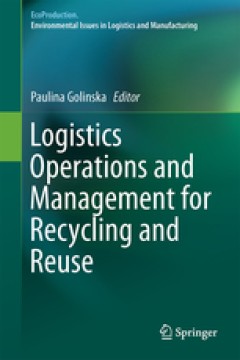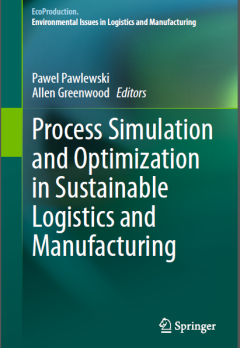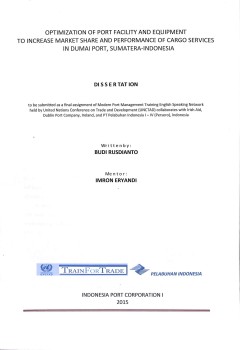Ditapis dengan

Capacity Planning for Mega Container Terminals with Multi-Objective and Multi…
Container terminals play a signi cant role as representative logistics facilities for contemporary trades by handling outbound, inbound, and transshipment containers to and from the sea (shipping liners) and the hinterland (consignees). Capacity planning is a fundamental decision process when constructing, expanding, or renovating a container terminal to meet the demand, and the outcome of this…
- Edisi
- 2017
- ISBN/ISSN
- 2472-5862
- Deskripsi Fisik
- 24 p.
- Judul Seri
- IISE Transactions
- No. Panggil
- ATC LO HAO c

Automated guided vehicle system for two container yard layouts
The explosive growth in the freight volumes has put a lot of pressure on seaport authorities to find better ways of doing daily operations in order to improve the performance and to cope with avalanches of containers processing at container terminals. Advanced technologies, and in particular automated guided vehicle systems (AGVS), have been recently proposed as possible candidates for improvin…
- Edisi
- 2014
- ISBN/ISSN
- -
- Deskripsi Fisik
- 20 p.
- Judul Seri
- Transportation Research Part C
- No. Panggil
- ATC LO LIU a

A simulation optimization approach for solving the dual-cycling problem in co…
Dual cycling is an operation technique whereby quay cranes perform loading and unloading operations simultaneously in the same ship bay. In this article, a mixedinteger programming model for quay crane dual-cycling scheduling is developed. The model considers the stowage plan of outbound containers and the operation sequence of quay cranes. To solve the model, a heuristic method, called bi-leve…
- Edisi
- 2015
- ISBN/ISSN
- -
- Deskripsi Fisik
- 23p
- Judul Seri
- Maritime Policy & Management: The flagship journal of international shipping and port research
- No. Panggil
- ATC LO ZEN a

A note on a dynamic space-allocation method for outbound containers
Storage space is a critical resource in port container terminals. This paper discusses how to allocate storage space for outbound containers that will arrive at a storage yard. The main objectives of space allocation are to utilize space efficiently and make loading operations more efficient. Objective functions and constraints of both the direct and the indirect transfer systems are described …
- Edisi
- 22 November 1999
- ISBN/ISSN
- -
- Deskripsi Fisik
- 10p
- Judul Seri
- European Journal of Operational
- No. Panggil
- ATC LO KIM a

Process Simulation and Optimization in Sustainable Logistics and Manufacturing
The EcoProduction Series is a forum for presenting emerging environmental issues in Logistics and Manufacturing. Its main objective is a multidisciplinary approach to link the scientific activities in various manufacturing and logistics fields with the sustainability research. It encompasses topical monographs and selected conference proceedings, authored or edited by leading experts as well as…
- Edisi
- -
- ISBN/ISSN
- 978-3-319-07347-7
- Deskripsi Fisik
- 182P
- Judul Seri
- Environmental Issues in Logistics and Manufacturing
- No. Panggil
- TXT LO PAW p

Supply Chain Optimization through Segmentation and Analytics
In a meeting with a COO (Chief Operating Officer) the author was told, “We have had dozens of consulting companies through here, each telling us that they know the best way to solve our productivity and logistics problems. But every one of them only solves a small part of the problem. Are you going to come in here and give me another solution that fixes a part of our problem but leaves us mis…
- Edisi
- 2014
- ISBN/ISSN
- 13: 978-1-4665-8477-
- Deskripsi Fisik
- 246P
- Judul Seri
- Series on Resource Management
- No. Panggil
- TXT MG PLE s

Study on berth planning problem in a container seaport: Using an integrated p…
This paper provides an integrated solution for two common processes in a container seaport: namely, the Berth Allocation Process (BAP) and the Crane Scheduling Process (QCSP). These are formulated through a Bi-Level Programming (BLP) approach, which is used to characterize the highly interrelated relationships between the two processes and simultaneously, identify an integrated solution for bot…
- Edisi
- -
- ISBN/ISSN
- 0360-8352
- Deskripsi Fisik
- 10 p.
- Judul Seri
- Computers & Industrial Engineering
- No. Panggil
- ATC PO ONG s

Solving simulation optimization problems on grid computing systems
The optimal assignment of berth slots and cranes to shipping services is the central logistics problem at modern marine container terminals and should be formulated to specifically account for its stochastic nature. We use a computational grid to solve a major seaport logistic problem by a simulation optimization approach centred around a queuing network model of the logistic process of interes…
- Edisi
- -
- ISBN/ISSN
- 0167-8191
- Deskripsi Fisik
- 13 p.
- Judul Seri
- Parallel Computing
- No. Panggil
- ATC PO ANA s

Estimating an origin–destination table for US imports of waterborne contain…
Containerized freight imports into the US are growing at an average of 10% per year. This traffic is concentrated at a small number of US seaports. It is therefore important to have an accurate understanding of the flow of containers from their origin country through these seaports to their final destination. This paper develops an optimization model to estimate route flows and a corresponding …
- Edisi
- -
- ISBN/ISSN
- 1366-5545
- Deskripsi Fisik
- 16 p.
- Judul Seri
- Transportation Research Part E
- No. Panggil
- ATC PO INE e

Logistics operations, supply chain management and sustainability
- Edisi
- -
- ISBN/ISSN
- 978-3-319-07287-6
- Deskripsi Fisik
- -
- Judul Seri
- -
- No. Panggil
- TXT LO Gol l
- Edisi
- -
- ISBN/ISSN
- 978-3-319-07287-6
- Deskripsi Fisik
- -
- Judul Seri
- -
- No. Panggil
- TXT LO Gol l

Process simulation and optimization in sustainable logistics and manufacturing
- Edisi
- -
- ISBN/ISSN
- 978-3-319-07347-7
- Deskripsi Fisik
- -
- Judul Seri
- -
- No. Panggil
- TXT LO Paw p
- Edisi
- -
- ISBN/ISSN
- 978-3-319-07347-7
- Deskripsi Fisik
- -
- Judul Seri
- -
- No. Panggil
- TXT LO Paw p

An optimization approach to determining the number of vendors to employ
Presents an approach for evaluating the number of vendors to employ in a procurement situation using multiobjective programming (MOP) and data envelopment analysis (DEA). The approach advocates developing vendor-order quantity solutions (referred to as supervendors) using MOP and then evaluating the efficiency of these supervendors on multiple criteria using DEA. Formulations are presented for …
- Edisi
- Volume 5 . Number 2 . 2000 . pp. 90±98
- ISBN/ISSN
- -
- Deskripsi Fisik
- 15 p.
- Judul Seri
- Supply Chain Management: An International Journal
- No. Panggil
- ATC LO DES a

A simulation based decision support system for logistics management
tThis paper deals with designing and developing a Decision Support System (DSS) that will be able tomanage the flow of goods and the business transactions between a port and a dry port. An integrated DSSarchitecture is proposed and specified and the main components are designed on the basis of simulationand optimization modules. In order to show the use and implementation of the DSS, this work …
- Edisi
- -
- ISBN/ISSN
- 1545-5955
- Deskripsi Fisik
- 11 p.
- Judul Seri
- Journal of Computational Science
- No. Panggil
- ATC LO FAN a

Pre-positioning commodities to repair maritime navigational aids
As the intensity of natural disasters increases, there is a need to develop policies and procedures to assist various agencies with moving aid to affected areas. One of the biggest limitations to this process is damage to transportation networks, in particular waterways. To keep waterways safe, aids to navigation (ATONs) are placed in various areas to guide mariners and ships to their final des…
- Edisi
- Vol. 3 No. 1, 2013
- ISBN/ISSN
- -
- Deskripsi Fisik
- 27 p.
- Judul Seri
- Journal of Humanitarian Logistics and Supply Chain Management
- No. Panggil
- ATC LO BRO p

Port and modal allocation of waterborne containerized imports from Asia to th…
An economic optimization model of waterborne containerized imports from Asia to the USA is described. Imports are allocated to alternative ports and logistics channels so as to minimize total transportation and inventory costs for each importer. Logistics channels include direct shipment of marine containers via truck or rail, and trans-loading in the hinterlands of the ports of entry from mari…
- Edisi
- -
- ISBN/ISSN
- -
- Deskripsi Fisik
- 20 p.
- Judul Seri
- -
- No. Panggil
- ATC PO LEA p

Bunker Purchasing With Contracts
The cost for bunker fuel represents a major part of the daily running costs of liner shipping vessels. The vessels, sailing on a fixed roundtrip of ports, can lift bunker at these ports, having differing and fluctuating prices. The stock of bunker on a vessel is subject to a number of operational constraints such as capacity limits, reserve requirements and sulphur content. Contracts are of…
- Edisi
- Vol. 16, 4,
- ISBN/ISSN
- 1479-2931
- Deskripsi Fisik
- 18 p
- Judul Seri
- -
- No. Panggil
- ATC LO PLU b

A genetic approach for freight transportation planning
This purpose of this paper is to present a methodology for optimally planning long-haul road transport activities through proper aggregation of customer orders in separate full-truckload or less-than-truckload shipments in order to minimize total transportation costs.
- Edisi
- Vol. 106 Iss 5 pp. 719 - 738
- ISBN/ISSN
- 0263-5577
- Deskripsi Fisik
- 22 p.
- Judul Seri
- Industrial Management & Data Systems
- No. Panggil
- ATC LO CAP a

Applying the doe toolkit on a lean-and-green six sigma maritime-operation imp…
The purpose of this paper is to provide a case study on endorsing process improvement in maritime operations by implementing design of experiments on Lean Six Sigma performance responses. It is demonstrated how process efficiency and environmental muda may be dealt with simultaneously in a lean-and-green project driven by hardcore Six Sigma tools
- Edisi
- Vol. 2 Iss 3
- ISBN/ISSN
- -
- Deskripsi Fisik
- 17 pages
- Judul Seri
- International Journal of Lean Six Sigma
- No. Panggil
- ATC MR GEO a

Value recovery network design for product returns
The purpose of this paper is to use a conceptual model from literature for designing value recovery (VR) networks for three categories of post‐consumer product returns.
- Edisi
- Vol. 38 Issue: 4, pp.311-331
- ISBN/ISSN
- -
- Deskripsi Fisik
- 24 p.
- Judul Seri
- International Journal of Physical Distribution & Logistics Management
- No. Panggil
- ATC LO SRI v

Spare parts optimization process and results: OPUS10 cases in the Norwegian D…
The paper has two main aims: to focus on how the spare parts optimization process was conducted in the Norwegian Defence procurement projects that had used the system approach based on OPUS10, and whether coordination issues affected the process and results; and to analyse empirical data in order to evaluate whether the theoretical claim of the system approach used through OPUS10, being better …
- Edisi
- Vol. 39 No. 1, 2009 pp. 8-27
- ISBN/ISSN
- -
- Deskripsi Fisik
- 22 p.
- Judul Seri
- International Journal of Physical Distribution & Logistics Management
- No. Panggil
- ATC LO TYS s

Routing of supply vessels to petroleum installations
In the Norwegian oil and gas industry the upstream logistics includes providing the offshore installations with needed supplies and return flow of used materials and equipment. This paper considers a real-life routing problem for supply vessels serving offshore installations at Haltenbanken off the northwest coast of Norway from its onshore supply base. The purpose of the paper is to explore ho…
- Edisi
- Vol. 37 No. 2, 2007 pp. 164-179
- ISBN/ISSN
- -
- Deskripsi Fisik
- 18 p.
- Judul Seri
- International Journal of Physical Distribution & Logistics Management
- No. Panggil
- ATC LO GRI r

Model and approach of fuzzy bilevel decision making for logistics planning pr…
This study aims to develop a decision making model and approach for logistics planning problem which naturally involves two or more decision units at a hierarchical structure. Such a decision problem in practice often involves uncertain and imprecise factors with the parameters of a bilevel decision model, either in the objective functions or constraints.
- Edisi
- Vol. 20 No. 2, 2007 pp. 178-197
- ISBN/ISSN
- -
- Deskripsi Fisik
- 27 p.
- Judul Seri
- Journal of Enterprise Information Management
- No. Panggil
- ATC LO ZHA m

Joint inventory and constant price decisions for a continuous review system
The purpose of this paper is to study joint inventory and pricing strategy for a continuous inventory review system. While dynamic pricing decisions are often studied in the literature along with inventory management, the authors’ aim in this study is to obtain a single long-run optimal price; also to gain insight about how to obtain the optimal price and inventory control variables simultane…
- Edisi
- Vol. 42 No. 2, 2012 pp. 174-202
- ISBN/ISSN
- -
- Deskripsi Fisik
- 30 p.
- Judul Seri
- International Journal of Physical Distribution & Logistics Management
- No. Panggil
- ATC LO KIE j

Customer service: the distribution of seasonal food products under risk
Addresses important logistical considerations in the distribution of a seasonal food product. While continued attempts have been made to maintain high levels of customer service within the food industry, the degree of uncertainty in the distribution channel itself often undermines management’s efforts to procure adequate stock of product during peak demand season. Develops a stochastic dyna…
- Edisi
- Vol. 26 No. 1, 1996, pp. 25-39.
- ISBN/ISSN
- -
- Deskripsi Fisik
- 17 p.
- Judul Seri
- International Journal of Physical Distribution & Logistics
- No. Panggil
- ATC LO BLA c

Improving social welfare chain using optimal planning model
The purpose of this study is to introduce the concept of social welfare chain and address the challenges in decision making through the development of an optimal planning model for a nongovernmental organization (NGO). The distinctive properties of the social welfare chain and its relationship with the humanitarian relief chain in the context of supply chain management are also discussed. The p…
- Edisi
- Volume 15 · Number 4 · 2010 · 290–305
- ISBN/ISSN
- -
- Deskripsi Fisik
- 18 p.
- Judul Seri
- Supply Chain Management: An International Journal
- No. Panggil
- ATC LO ORT i

Optimality analysis of facility location problems using response surface meth…
Response surface methodology (RSM) is used for optimality analysis of the cost coefficients in mixed integer linear programming. This optimality analysis goes beyond traditional sensitivity and parametric analysis in allowing investigation of the optimal objective function value response over pre-specified ranges on multiple problem parameters. Design of experiments and least squares regression…
- Edisi
- Vol. 31 No. 1, 2001
- ISBN/ISSN
- -
- Deskripsi Fisik
- 17 p.
- Judul Seri
- International Journal of Physical Distribution & Logistics
- No. Panggil
- ATC LO MOO o

Sea container terminals: new technologies and OR models
Owing to a rapid growth in world trade and a large increase in the flow of containerized goods, sea container terminals play a vital role in globe-spanning supply chains. Container terminals should be able to handle large ships, with large call sizes within the shortest time possible, and at competitive rates. In response, terminal operators, shipping lines and port authorities are investing in…
- Edisi
- -
- ISBN/ISSN
- -
- Deskripsi Fisik
- 38 p.
- Judul Seri
- Maritime Economics & Logistics
- No. Panggil
- ATC LO ROY s

Optimization of port facility and equipment to increase market share and perf…
Indonesia Port Corporatioon I have a business unit of good services segment includes activities stevedoring which market segment to compete with other comapnies. Stevedoring business units owned by the owner of the ship and not as the owner of the goods. To be more competitive and increase market share Indonesia Port Corporation I need to have a strategy, among others, in to optimize and equipm…
- Edisi
- -
- ISBN/ISSN
- -
- Deskripsi Fisik
- vii, 27 p., ; 29 cm
- Judul Seri
- -
- No. Panggil
- TD PO RUS o
 Karya Umum
Karya Umum  Filsafat
Filsafat  Agama
Agama  Ilmu-ilmu Sosial
Ilmu-ilmu Sosial  Bahasa
Bahasa  Ilmu-ilmu Murni
Ilmu-ilmu Murni  Ilmu-ilmu Terapan
Ilmu-ilmu Terapan  Kesenian, Hiburan, dan Olahraga
Kesenian, Hiburan, dan Olahraga  Kesusastraan
Kesusastraan  Geografi dan Sejarah
Geografi dan Sejarah